|
|
|||
 |
Phnom Penh |
||
|
Phnom Penh, Monday, May 3, 2004
I
now know the real meaning of the phrase: “hanging on by your
fingernails”. That’s exactly what I But back to the motorbike…. On our sightseeing schedule of Phnom Penh, we needed transport when it became obvious that walking was not an option in the midday heat. Tourists have to appear only a little uncertain in central Phnom Penh, and look around for a moment or two, before half a dozen moto riders zoom in around them, all trying for the job. So, seeing no readily available alternative, and with a shrug of the shoulders, we climbed onto the backs of two motos, and off we went. First up, I was hanging on (not to the rider, but a conveniently placed metal bar), with my eyes closed, but, courage returned and by the end of the ride, 10 minutes later, it was a case of “look DB, no hands”. Not for nothing does a tourist guide book describe Phnom Penh’s drivers as “visually impaired psychopaths”. Spot on. *** Our destination on the bikes was Tuol Sleng, the museum on the site of a detention centre known only as “S-21” where thousands of Khmers were tortured and killed by their countrymen, followers of Pol Pot in the regime of the Khmer Rouge in the late 1970s. The visit to the prison camp will be imprinted forever on my memory, even though I couldn’t bring myself to look at all of the photographs on display. The prison was a former suburban high school, and was used for detention, interrogation and torture leading inevitably to death. From the outside, the buildings appear today simply as rather rundown school buildings (below), but now, they house a genocide museum, dedicated to the memory of those who suffered there.
The Khmer Rouge, like the Nazis of World War 2, documented their activities in oppressive detail, with the added use of extensive photography: thousands of photos of their victims, both dead and alive and being tortured are shown on display racks at the museum. Today, we visited the related memorial stupa, 18km out of Phnom Penh, the site of the infamous “Killing Fields”, where the bodies of eight thousand of those who had been “processed” through S-21 were found in mass graves, after the Khmer Rouge were ousted by the invading Vietnamese in 1979. The pits the bodies were thrown into are still there, a shock to our Australian psyches. These memorials are only two of dozens scattered throughout Cambodia, in memory of the unknown millions of people who died during the four year reign of terror.
The visit has prompted me to buy at least one book (with probably
more to come) on the subject of the “Dark Times”,
DB at the stupa outside Phnom Penh, erected in memory of those who died in the Killing Fields there. The skulls of more than 8000 Khmer Rouge victims are lined up on glass shelves reaching high into the tower *** Our arrival in Phnom Penh on Saturday afternoon was an hour and a half late – this was only the fourth time I have left KL’s International Terminal – and on all four occasions the flight has been late.. Plus, there was an extra little puzzle – both Dave and I are 99% sure our baggage was searched at some stage (things rearranged, and left out of containers; toiletry bags left unzipped etc). Only one item was missing when we checked – the battery charger for our camera; not a significant theft, just an annoying one, as we do have a spare battery with us. Or maybe we had just forgotten to pack it. We’ll find out when we get back. A little puzzle arose after we landed – Cambodia, although just about on the same longitude as Malaysia, is an hour behind!. I can’t work out the rationale for that little quirk of the time zone system. Despite our late arrival into Phnom Penh, the hotel’s pick-up driver was still patiently waiting to take us to the Sunway Hotel, a four-star chain hotel conveniently located a short walk from Sisowath Quay. The colourful esplanade, vibrantly alive at night, features many tourist-oriented restaurants and hotels, but I had been advised we should head for the Foreign Correspondents Club, overlooking the junction of the Tonlé Sap and Mekong rivers.
*** Last night, we used the happy hour at neighbouring Le Royal hotel to good advantage – two Singapore Slings for $6. Le Royal, the flashest hotel in town, where the rate for the top suite for a night would support several Cambodian families for a year, is now part of the Raffles chain of Singapore fame. **** The heat is again a major problem for me. Phnom Penh is hotter than KL, and Lord knows how I am going to cope with Siem Reap and Angkor Wat. Yesterday, we set out on foot from the hotel to see the Royal Palace. By the time we arrived there, a distance of only a dozen blocks or so, I knew that walking very far was going to be out of the question. Nonetheless, the stroll was an instructive one, enabling us to see the degradation of the capital close up. A few of the major roads are quite attractive, lined with flowering frangipani trees, but only a few main streets are tar-sealed; even in the centre of the city, dirt or mud roads (depending on the season) are common, and the obvious filth and poor living conditions were hard to believe. I had heard the Phnom Penh reflected the years that it was a French colony, with much French colonial architecture. I wouldn’t know about that, not having seen too many French slums.
DB
even went to say to say that it was the “most rugged” city he’d
seen, and in Asia, he’s seen a few. (right) inner-city Phnom Penh Cleaned up, it could be quite attractive… A $4-million program to clean up the streets has been announced, but there’s no way that’s going to make very much difference. It’s a billion dollar job – and there’s clearly no money like that in the budget. The monetary system is in a bad way – the US dollar is the de facto currency, with the local riel being used only for small change. That’s just as well, with the exchange rate being 4000 riel to $1. (Yes, that’s right, four thousand: I didn’t mistype an extra zero.
|
|||
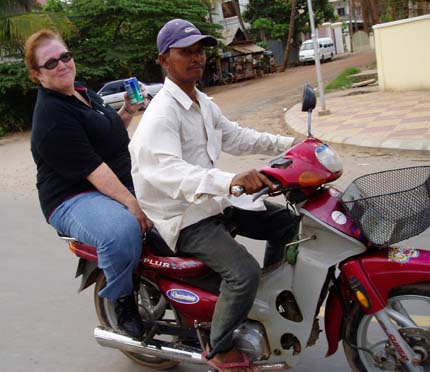 did yesterday, when, for the
first time in my life, I rode pillion passenger on a taxi
motorcycle. Motos, as they are called in Phnom Penh, are the main
form of transport for hire…Public transport is non-existent, and
hotel hire cars charge biggish dollars. The other options are
motorized rickshaws, and the very practical tuk tuk, which we
also used.
did yesterday, when, for the
first time in my life, I rode pillion passenger on a taxi
motorcycle. Motos, as they are called in Phnom Penh, are the main
form of transport for hire…Public transport is non-existent, and
hotel hire cars charge biggish dollars. The other options are
motorized rickshaws, and the very practical tuk tuk, which we
also used.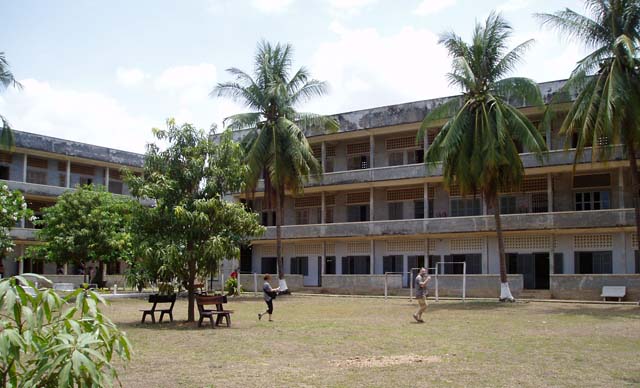
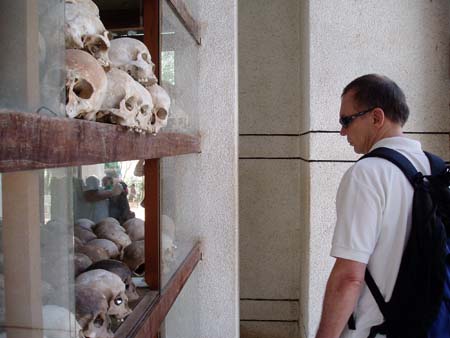
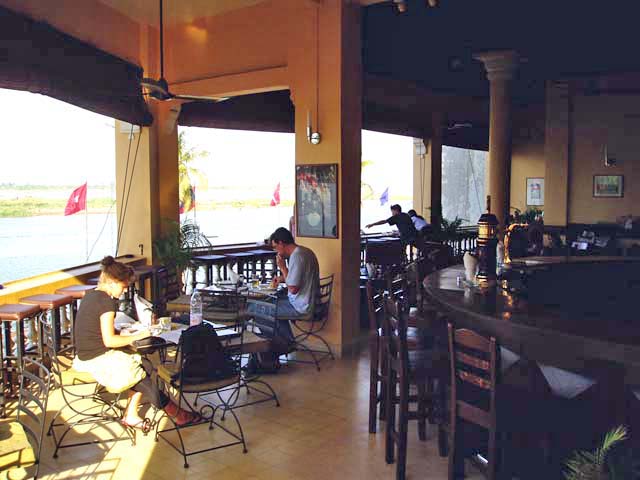 The
recommendation was a good one; the beer and food were just right,
and the river breeze blowing through the open first floor club
lounge (left) helped me relax despite the heat and humidity.
I’m told the club has rooms available to accommodate visiting
journalists, with the mini-bars stocked with one litre bottles of
spirits, instead of the miniatures normally available in hotel
rooms. I guess they know their clientele.
The
recommendation was a good one; the beer and food were just right,
and the river breeze blowing through the open first floor club
lounge (left) helped me relax despite the heat and humidity.
I’m told the club has rooms available to accommodate visiting
journalists, with the mini-bars stocked with one litre bottles of
spirits, instead of the miniatures normally available in hotel
rooms. I guess they know their clientele.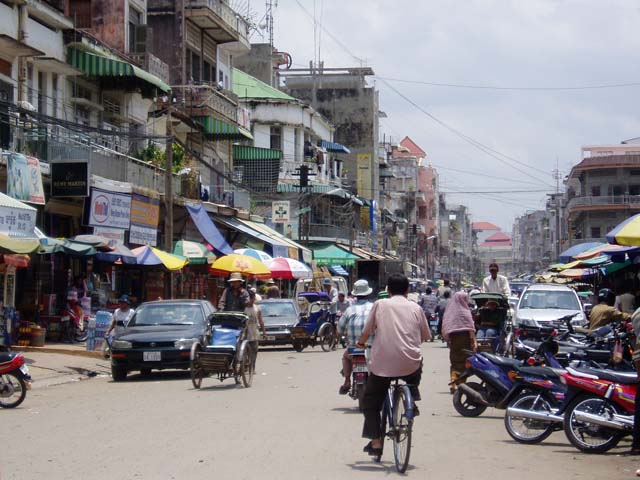 It surpasses Dacca in
Bangladesh, which was his benchmark before this.
It surpasses Dacca in
Bangladesh, which was his benchmark before this.